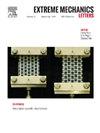Programming the energy landscape of 3D-printed Kresling origami via crease geometry and viscosity
IF 4.5
3区 工程技术
Q2 MATERIALS SCIENCE, MULTIDISCIPLINARY
引用次数: 0
Abstract
Origami extends beyond intricate paper creations, envisioning revolutionary engineering applications. While 3D printing has simplified fabricating complex structures, Kresling origami remains predominantly paper based due to the challenge of achieving multistable behavior, especially at a small scale. Our study focuses on investigating modifications to the energy landscape induced by changes in crease geometrical parameters, addressing the effects of viscoelasticity in the creases. The latter aspect is investigated using different rubbery materials with varying relaxation moduli. Considering the limitations of manufacturing techniques, we also provide design insights for crease geometry and distribution, along with photopolymers suitable for fabricating both multi- and monomaterial bistable cells, at both micro- and macro- scales. By leveraging 3D printing and overcoming its material and technological constraints, our goal is to contribute to a deeper understanding of the mechanics of 3D printed materials and broaden their applications into new frontiers.

通过折痕几何和粘度编程3d打印Kresling折纸的能量景观
折纸超越了复杂的纸张创作,设想了革命性的工程应用。虽然3D打印简化了复杂结构的制造,但由于实现多稳定行为的挑战,特别是在小范围内,Kresling折纸仍然主要是基于纸的。我们的研究重点是调查由折痕几何参数变化引起的能量景观的变化,解决折痕中的粘弹性影响。后一个方面的研究使用不同的橡胶材料具有不同的松弛模量。考虑到制造技术的局限性,我们还提供了折痕几何形状和分布的设计见解,以及适合在微观和宏观尺度上制造多材料和单材料双稳态电池的光聚合物。通过利用3D打印和克服其材料和技术限制,我们的目标是有助于更深入地了解3D打印材料的机制,并将其应用扩展到新的领域。
本文章由计算机程序翻译,如有差异,请以英文原文为准。
求助全文
约1分钟内获得全文
求助全文
来源期刊

Extreme Mechanics Letters
Engineering-Mechanics of Materials
CiteScore
9.20
自引率
4.30%
发文量
179
审稿时长
45 days
期刊介绍:
Extreme Mechanics Letters (EML) enables rapid communication of research that highlights the role of mechanics in multi-disciplinary areas across materials science, physics, chemistry, biology, medicine and engineering. Emphasis is on the impact, depth and originality of new concepts, methods and observations at the forefront of applied sciences.
 求助内容:
求助内容: 应助结果提醒方式:
应助结果提醒方式:


